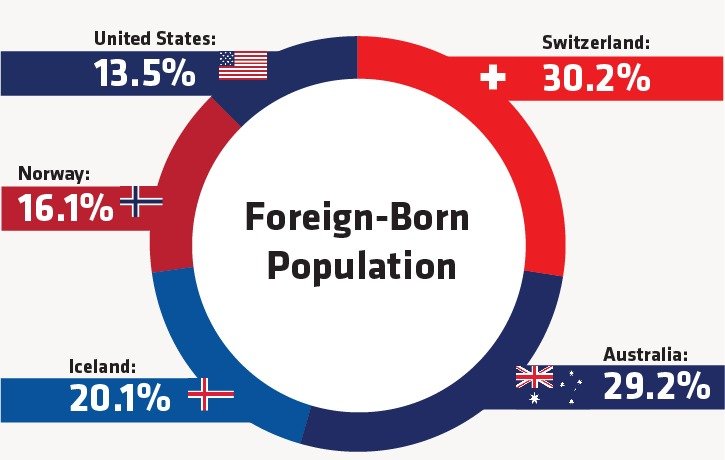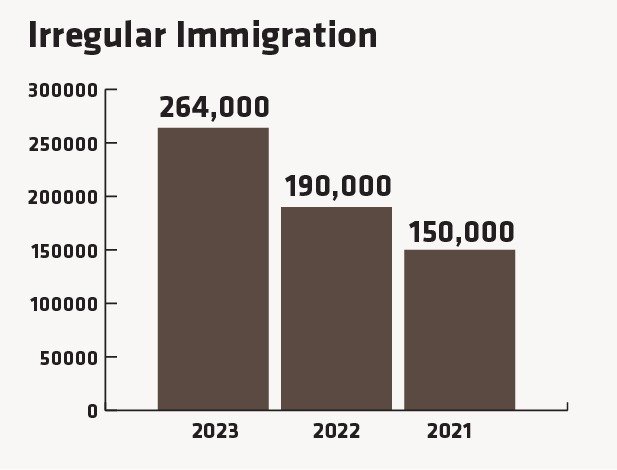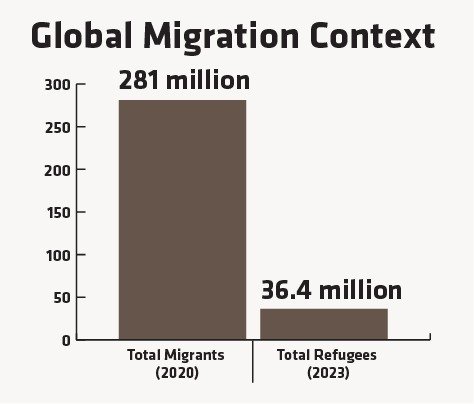The Mediterranean Sea stands as the world’s deadliest migration route, where desperate individuals flee violence, repression, or poverty in search of sanctuary within the European Union. Spanning from Morocco to Turkey across 970,000 square miles, this route has claimed thousands of lives, marking 2023 as the deadliest year since the aftermath of Europe’s migrant crisis from 2014 to 2016. By late November 2023, nearly 239,000 migrants had reached Europe via this treacherous path, while almost 3,000 perished in the attempt, as reported by the International Organization for Migration.
You can also read: Biden’s Mental Fitness Concerns: What Experts and Polls Reveal
Despite ongoing reforms in migration, asylum, integration, and border management policies within the EU, criticisms persist over tactics that allegedly exacerbate migrant pushbacks and fatalities at sea. Over the past decade, more than 28,000 people have lost their lives attempting this crossing, leading the United Nations to designate the central Mediterranean as the most dangerous migration route globally.

The EU’s approach, criticized for its impact on the journey’s lethality, includes policies that refrain from proactive search and rescue efforts unless vessels issue emergency distress calls. This practice has inadvertently encouraged traffickers to dispatch unsafe, overcrowded boats in hopes of rescue by entities such as Frontex or EU member state coast guards like Italy and Greece.
5.3% of EU Population are Non-EU Citizens, Mostly in Four Countries
Recent efforts at deterrence, under Italian Prime Minister Georgia Meloni’s leadership since late 2022, have further complicated the EU’s maritime borders, reducing the capacity of search and rescue operations. Additionally, the EU has trained the Libyan Coast Guard—linked to militias—to intercept humanitarian missions and detain migrants in for-profit Libyan prisons notorious for abuse. Reports detail egregious conditions including extortion, torture, rape, and forced labor.
In 2022, European Union (EU) Member States issued nearly 3.7 million new residence permits, excluding arrivals from Ukraine, marking a significant increase from previous years—2.9 million in 2021 and three million in 2019. Concurrently, there were 875,000 new asylum applications, a 52% surge from 2021 and a 38% rise from 2019, according to Eurostat.

As International Migrants Day approaches on 18 December, UNRIC emphasizes the importance of these statistics. Data from Eurostat, the European Commission, and the International Organization for Migration (IOM) offer factual insights into EU migration trends, dispelling misconceptions with empirical evidence.
As of January 1, 2022, 23.8 million non-EU citizens were residing in the EU, constituting 5.3% of the bloc’s 447 million inhabitants. The majority—three-quarters—are concentrated in Germany, Spain, France, and Italy. When including EU citizens born outside the bloc, the total rises to 38 million people, equivalent to 8.5% of the EU’s population. Including EU citizens migrating within the bloc further increases the share of foreign nationals to 12.5%, lower than rates in other high-income countries like Switzerland (30.2%), Australia (29.2%), Iceland (20.1%), Norway (16.1%), and the United States (13.5%).

Irregular Immigration a Minority in EU, Majority of Migrants Travel Legally
While irregular immigration garners attention, it represents a minority of migration flows. Compared to global figures—281 million migrants in 2020 and 36.4 million refugees in 2023—the overwhelming majority travel through legal channels safely.
By November 27, 2023, IOM recorded 264,000 irregular entries into the EU by land or sea, up from nearly 190,000 in 2022 and 150,000 in 2021, accounting for 6.6% of Europe’s migration intake from other regions in the same year. These figures underscore the complexity and scale of migration management in the EU, highlighting the need for evidence-based policies to address challenges while recognizing the contributions of migrants to European societies.

Europe faces an unprecedented maritime refugee crisis, a defining challenge of the early 21st century, with profound implications for humanitarian efforts, regional stability, and global perception. In the first half of this year alone, 137,000 refugees and migrants undertook perilous journeys across the Mediterranean, often aboard unsafe vessels, resulting in tragic losses. The catastrophic shipwreck in mid-April 2015, claiming 800 lives, marked a grim turning point, prompting urgent EU responses and highlighting the escalating human toll at sea.

Central questions emerge:
Who are these arrivals, why are they fleeing, and how can Europe effectively aid them while addressing root causes? The majority are refugees escaping war, conflict, or persecution, primarily from Syria, Afghanistan, Iraq, and Somalia. Europe is responsible for providing sanctuary and ensuring maritime rescue operations, crucial for preventing further loss of life.
Bangladeshi Youth Among Thousands Risking All for European Dreams
The allure of employment has driven countless young people to embark on dangerous voyages across the Mediterranean Sea, bound for the shores of Europe, particularly Italy. Among the hundreds of thousands who undertake this hazardous journey from various nations, thousands hail from Bangladesh. According to UNHCR, nearly 160,000 individuals embarked on such risky crossings last year alone, with approximately 13,000 Bangladeshis among them. However, for many of these illegal migrants, fortune does not favor the brave. Too often, these ill-fated travelers meet grim fates—tortured to death by traffickers or consigned to a watery grave aboard overcrowded and unseaworthy vessels.
Origin of Refugees and Migrants
- Primary Countries:
- Syria
- Afghanistan
- Iraq
- Somalia
- Reasons for Fleeing:
- War
- Conflict
- Persecution
In 2023, the UN documented 1,897 individuals who went missing during treacherous voyages across the Mediterranean Sea to Italy.
Despite the media spotlight on such tragic incidents, the influx of new recruits enticed by unscrupulous brokers continues unabated, perpetuating a cycle of exploitation and despair.
In 2022, approximately 15,000 Bangladeshi youths attempted to migrate illegally to Italy with the aid of traffickers. A study covering the period between 2009 and 2023 reveals that around 70,900 individuals traveled to Europe through Libya, utilizing the services of traffickers. According to UNHCR, traffickers use seven primary routes to Europe, all originating from Libya or Turkey. The central Mediterranean route, beginning in Libya and ending in Italy, is the most frequented.
Deceived by Traffickers, Held Ransom in ‘Game Ghor’
These young Bangladeshis, deceived by traffickers, pay as much as Tk1.5 million each to brokers as passage money. However, once in the clutches of traffickers, their ordeal begins. Held to ransom and subjected to inhumane treatment, they endure a harrowing journey as their captors extort additional money from their families back home. The moment they enter the so-called ‘game ghor’, a temporary shelter that serves as a torture chamber, their dreams are shattered.
‘Game Ghor’ (Torture Chambers): Temporary shelters used for torture and extortion
Yet, despite the dangers, youths continue to be drawn to these perilous journeys. The stories of those who succeed despite the hardships inspire others to take the risk. Traffickers’ agents exploit this hope, often being familiar faces who persuade their victims and families with promises of a bright future in Europe.
The conjurors who lure naive village youths into deadly journeys to Europe are often known to their victims, making it imperative to expose them. The Public Security Division of the Home Ministry, in its National Plan of Action for Prevention and Suppression of Human Trafficking 2023-25, has identified Cox’s Bazar, Mymensingh, and Jessore as human trafficking hotspots. However, what concrete measures have been taken to curb youth trafficking from these regions?
Identified Hotspots in Bangladesh (2023-25):
- Cox’s Bazar
- Mymensingh
- Jessore
Despite the existence of anti-trafficking tribunals across seven divisions, empowered by the Prevention and Suppression of Human Trafficking Act, justice remains elusive. With around 3,700 human trafficking cases pending against 34,500 accused individuals, the adage ‘justice delayed is justice denied’ rings painfully true. The traffickers orchestrating this grim procession of death must face stringent punishment.


